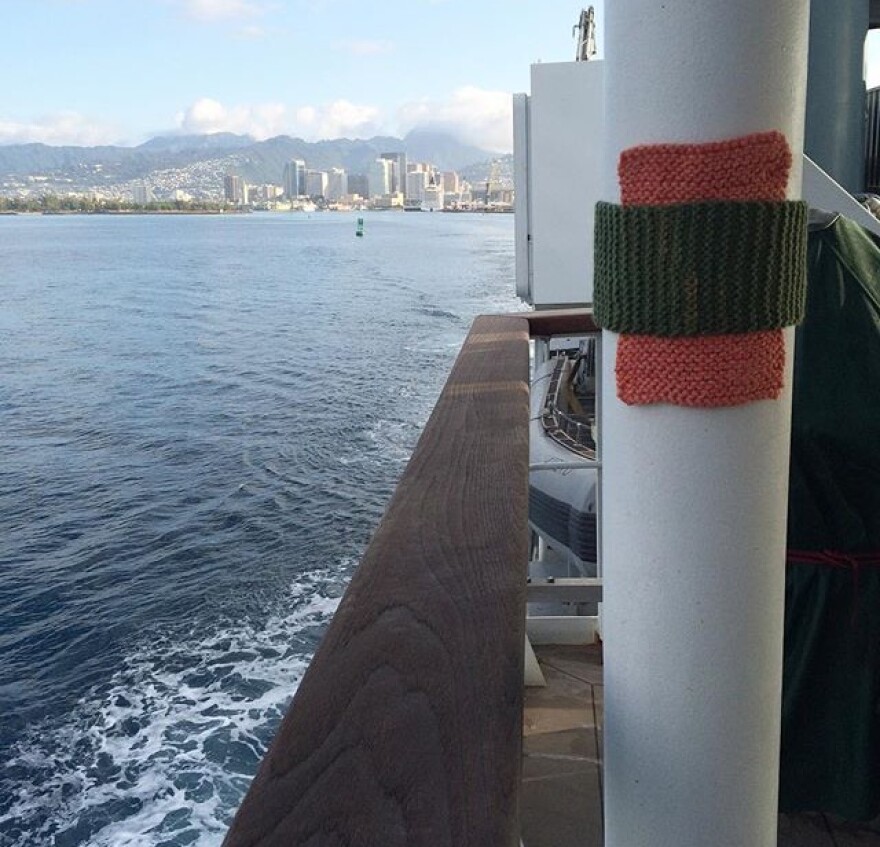A research ship in the middle of the Pacific Ocean is not the kind of place where you would expect to find artists. But a new partnership is bringing together art and science through a residency program on board The Falkor, part of the Schmidt Ocean Institute. HPR’s Molly Solomon caught up with a local fiber artist who was able to hop aboard.

Michelle Schwengel-Regala’s suitcase doesn’t contain what you’d typically pack for a four week trip at sea. “I brought a lot of yarn in my suitcase today,” said Schwengel-Regala, who’s actually a yarn-bomber, a sort of urban graffiti artist, preferring fuzzy wool and silky threads instead of ink. She was recently chosen from more than a hundred applicants for an Artist-at-Sea residency program.
“These are very fine silk threads and it was set in this gradient of blue,” said Schwengel-Regala as she sorted through her suitcase of yarn, much of it harvested from a local sheep ranch on the Big Island. “For years I haven’t known what I would do with this, but I think something watery will come of this now.”

Up on deck, a crew of researchers make last minute preparations. Mak Saito, the chief scientist on board, leads me toward the back deck. “That’s where we’ll be doing our sampling operations for water and microbial populations,” said Saito.
This ship is a state of the art research vessel, capable of mapping the bottom of the ocean. Saito is a biogeochemist who studies trace elements in the oceans. This mission takes him from Honolulu to Tahiti to investigate life in areas of the ocean with very low levels of oxygen, called oxygen deficient zones. “It’s a region that once the oxygen gets low, there’s a lot of interesting chemistry and microbiology that happens,” Saito explains.
Those microbes and proteins that are able to survive in that environment could lead to a greater understanding of how our oceans function. Saito is hoping it also leads to creative inspiration. “So much of what we do is so hard to express to the public. But we feel it’s very important because the microbes have such a big influence on the chemistry of the planet. They are essentially creating the life support system that we rely on,” said Saito. “Finding new ways to get that message out is very exciting and appealing. Hopefully working with Michelle will help us find ways to bridge that gap.”

The intersection of art and science is nothing new to Michelle. She studied taxonomy and conservation biology in college and later became a science illustrator. “I don’t want to simply make it look like what you’d see in a research paper. I want it to be something beyond that and tell a broader story,” said Schwengel-Regala. “Especially since I’ll be working with a very welcoming medium, yarn is so fuzzy, soft and cozy. I think that has the chance to bring people’s interest into a subject they wouldn’t necessarily take the time to look at.”

One idea she has while on board harkens back to a piece of WWI naval history, something called dazzle camouflage. “There was a bold graphic pattern in contrasting colors that would be applied to the surface of the ship. It wasn’t so much to camouflage it into the sea landscape, but it was more to obscure the actual form and direction of the boat. I have brought some contrasting colored yarn with me, and I’m planning to stage some textile scenes around the boat,” explains Schwengel-Regala, who also may be performing a familiar activity. “I might be doing a little bit of yarn bombing while I’m on the boat as well.”

And Michelle has already left her artistic mark on the Falkor. Tucked around one of the ship’s poles is her local trademark: a small knitted spam musubi.





